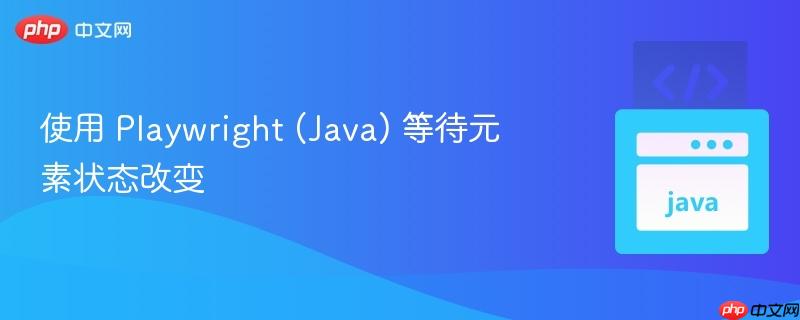
本文介绍如何使用 Playwright (Java) 等待页面元素状态发生改变。当页面元素始终存在,但其内容或状态会动态变化时,简单的等待加载完成或网络空闲并不能解决问题。本文提供了一种使用 Awaitility 库实现动态等待元素状态改变的方案,并附有代码示例和注意事项。
在 Web 自动化测试中,经常会遇到需要等待页面元素状态改变的情况。例如,点击一个按钮后,页面上的某个文本内容会发生变化,或者某个元素的可见性会发生改变。Playwright 提供了多种等待机制,但当元素始终存在,只是其状态动态变化时,简单的 waitForLoadState 或 NETWORKIDLE 可能无法满足需求。
例如,考虑一个表格,点击“停用”按钮后,表格中对应行的状态会从“激活”变为“停用”。如果直接使用 page.locate(columnSelector).textContent() 获取状态,由于元素一直存在,可能在状态更新完成前就获取到旧值,导致测试不稳定。
一种有效的解决方案是使用 Awaitility 库,它可以根据指定的条件进行轮询,直到条件满足或超时。
立即学习“Java免费学习笔记(深入)”;
Awaitility 简介
Awaitility 是一个 Java 库,用于简化异步操作的测试。它允许你指定一个条件,并定期检查该条件是否满足。如果条件在指定的时间内未满足,则会抛出异常。
使用 Awaitility 等待元素状态改变
以下是使用 Awaitility 等待元素状态改变的示例代码:
import org.awaitility.Awaitility;
import java.time.Duration;
import java.util.concurrent.Callable;
import com.microsoft.playwright.Page;
import com.microsoft.playwright.Locator;
public class WaitForElementStateChange {
public static void waitForElementTextChange(Page page, String locator, String expectedText, int timeoutSeconds) {
Callable<Boolean> wait = () -> {
Locator element = page.locator(locator);
return element.textContent().equals(expectedText);
};
Awaitility.await()
.atMost(Duration.ofSeconds(timeoutSeconds))
.pollInterval(Duration.ofMillis(500))
.until(wait);
}
public static void waitForElementVisibility(Page page, String locator, boolean isVisible, int timeoutSeconds) {
Callable<Boolean> wait = () -> {
Locator element = page.locator(locator);
return element.isVisible() == isVisible;
};
Awaitility.await()
.atMost(Duration.ofSeconds(timeoutSeconds))
.pollInterval(Duration.ofMillis(500))
.until(wait);
}
public static void main(String[] args) {
// 示例用法 (需要配置 Playwright 环境)
// Page page = ...; // 获取 Page 对象
// String columnSelector = "yourColumnSelector";
// String deactivateButton = "yourDeactivateButton";
// 点击停用按钮
// page.locator(deactivateButton).click();
// 等待状态变为 "停用"
// waitForElementTextChange(page, columnSelector, "停用", 30);
// 等待元素可见
// waitForElementVisibility(page, "yourElementSelector", true, 30);
}
}代码解释:
waitForElementTextChange 方法:
waitForElementVisibility 方法:
main 方法:
使用步骤:
添加 Awaitility 依赖:
在你的 Maven 或 Gradle 项目中添加 Awaitility 依赖。
<dependency>
<groupId>org.awaitility</groupId>
<artifactId>awaitility</artifactId>
<version>4.2.0</version>
<scope>test</scope>
</dependency>testImplementation 'org.awaitility:awaitility:4.2.0'
导入 Awaitility 类:
在你的 Java 文件中导入 org.awaitility.Awaitility 类。
调用 Awaitility.await() 方法:
使用 Awaitility.await() 方法配置等待行为,并指定等待的条件。
注意事项:
总结:
使用 Awaitility 库可以有效地解决 Playwright 中等待元素状态改变的问题。通过指定条件和轮询间隔,可以确保在元素状态更新完成后再进行后续操作,从而提高测试的稳定性和可靠性。 这种方法可以灵活地应用于各种需要动态等待的场景,例如等待文本内容改变、等待元素可见性改变等。
以上就是使用 Playwright (Java) 等待元素状态改变的详细内容,更多请关注php中文网其它相关文章!

每个人都需要一台速度更快、更稳定的 PC。随着时间的推移,垃圾文件、旧注册表数据和不必要的后台进程会占用资源并降低性能。幸运的是,许多工具可以让 Windows 保持平稳运行。

Copyright 2014-2025 https://www.php.cn/ All Rights Reserved | php.cn | 湘ICP备2023035733号